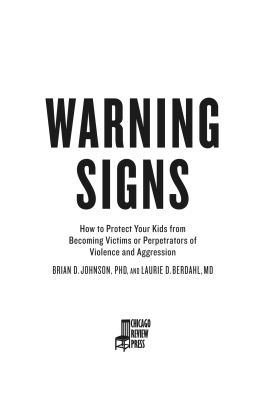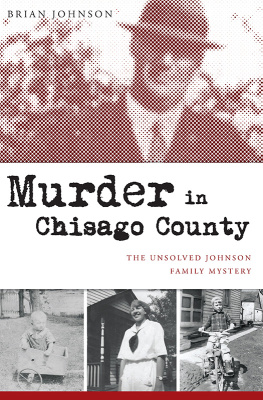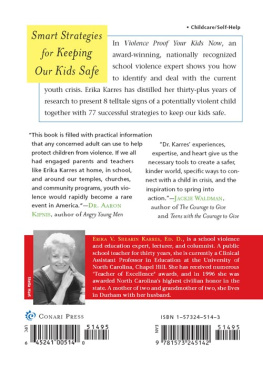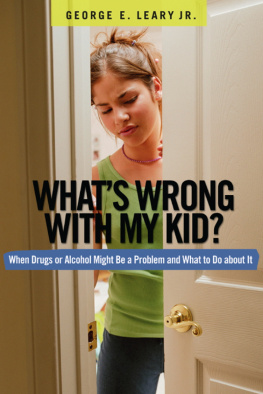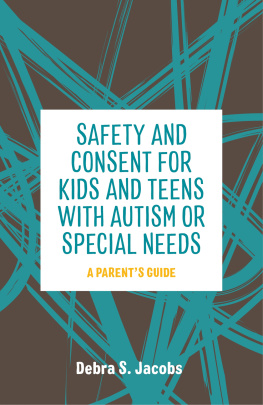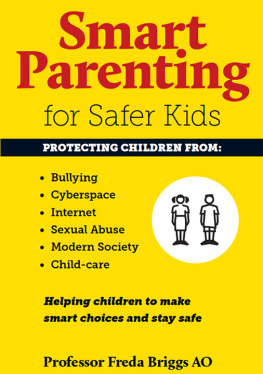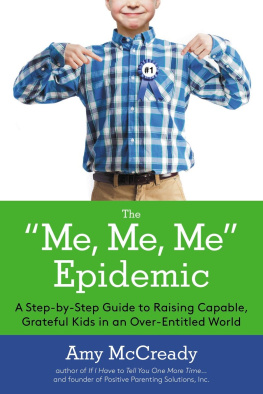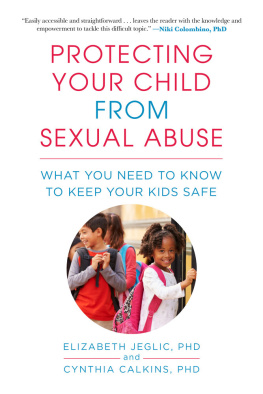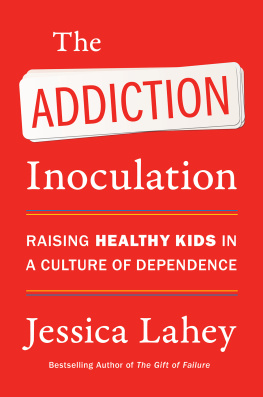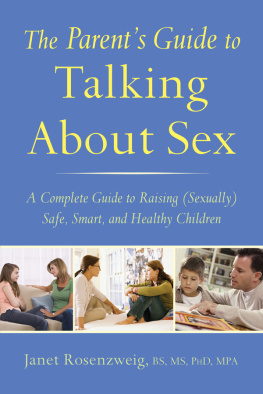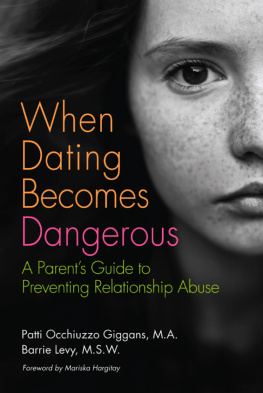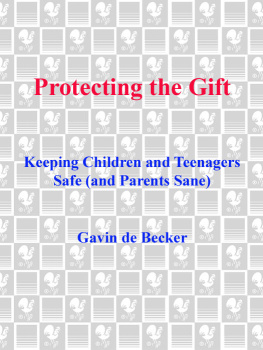Copyright 2016 by Brian D. Johnson and Laurie D. Berdahl
All rights reserved
Published by Chicago Review Press Incorporated
814 North Franklin Street
Chicago, Illinois 60610
Names: Johnson, Brian D., 1962 October 3 | Berdahl, Laurie D., author.
Title: Warning signs : how to protect your kids from becoming victims or
perpetrators of violence and aggression / Brian D. Johnson, PhD, and
Laurie D. Berdahl, MD.
Description: Chicago, IL : Chicago Review Press, 2016. | Includes
bibliographical references and index. | Description based on print version
record and CIP data provided by publisher; resource not viewed.
Identifiers: LCCN 2016000338 (print) | LCCN 2015048726 (ebook) | ISBN
9781613730430 (pdf) | ISBN 9781613730454 (epub) | ISBN 9781613730447
(Kindle) | ISBN 9781613730423 (paperback)
Subjects: LCSH: Parenting. | Parent and child. | Family life education. |
BISAC: FAMILY & RELATIONSHIPS / General. | PSYCHOLOGY / Developmental /
Child. | PSYCHOLOGY / Developmental / Adolescent.
Classification: LCC HQ755.8 (print) | LCC HQ755.8 .J643 2016 (ebook) | DDC
649/.1dc23
LC record available at http://lccn.loc.gov/2016000338
For the millions of victimized youth and the people trying to help them, and for those working to protect children from violence and aggression
Introduction
Charlotte was a free spirit who jumped, skipped, and ran to the beat of her own drum. She was boldness, she was mischief, and she was love. Her crazy antics made us laugh daily. Her insight and curiosity amazed us. We miss her singing loudly with the car radio, hearing her feet always at a run, never at a walk, down the hallway in our home.... She was and continues to be our brightest star in the sky.
Parents of six-year-old Charlotte Helen Bacon,
a first grader who was murdered at Sandy Hook
Elementary School in Newtown, Connecticut
Y oung Charlotte was one of twenty-six children and adults killed at Sandy Hook Elementary in December 2012, and her parents are among many forced to wrestle with their anguish after living through the nightmare. While our nation struggles to understand the heinous acts of Adam Lanza in Newtown and numerous young mass shooters since, many parents are asking, What is going on, and what can be done about it? How can we protect our children?
Some parents worry that a troubled youth they know could harm people, and others have to accept that their child did the unthinkable. Perhaps wanting to warn the public, Adams father, Peter Lanza, said, I want people to be afraid of the fact that this could happen to them.
Are events like Newtown usually preceded by warning signs that could have been acted upon to prevent tragedy? What factors lead young people to commit senseless acts of violence and are there warning signs for those? Research points to many underlying risk factors, and yes, there are often warning signs before young people harm themselves or others. Youll learn about these warning signs as you read this book.
When a young person commits an atrocity, many of us want to think that he or she had a mental illness and there was nothing anyone could have done to predict the event, because it makes disturbing scenarios more palatable. This would indicate that theres not much we can dobut fortunately, thats usually not the case. This book discusses warning signs relating to mental and emotional health, including those shown by Adam Lanza, but youll learn about other more significant risk factors for aggressive and violent behaviors, which, when recognized, can prompt productive, early intervention.
While we frequently hear news of events that we fear most, such as children being shot in schools or abducted, relatively few children will be victims of these. However, most American kids and young (or emerging) adults ages eighteen to twenty-four are victims or perpetrators of other forms of aggression and violence, with far-reaching consequences.
Aggression is attempting to inflict or inflicting physical or psychological harm to someone by physical, verbal, or situational means, or dominating someone by using power. Examples are taunting, manipulating, threatening, stealing, cheating, humiliating, excluding, and inducing fear. Many of these behaviors are part of bullying and relational aggression, which affect up to 30% of our children. Well show you how to help your children survive and even thrive in the midst of it.
More severe forms of physical aggressionsuch as physical assault with or without a weapon, threats with a weapon, vandalism, rape, murder, and child and animal abuseare considered violence. Cutting and suicide are forms of violence against oneself. Compared to any other age group, adolescents are the most frequent victims of violence.
How many youth are victimized? Here are some statistics for you. According to a 2013 study in JAMA (Journal of the American Medical Association) Pediatrics, more than 40% of kids up to age seventeen were physically assaulted at least once in the prior year. During that same period, almost 60% were exposed to violence, crime, or abuse as victims or witnesses, and about 25% were victimized by robbery, theft, or vandalism. In 2013, almost six hundred thousand young people up to age twenty-four were treated for physical assault injuries, and more than two hundred thousand of these people were younger than eighteen.
A hundred years ago, infectious diseases were top causes of death in children. Today, children are slain by murder much more often than disease, and are murdered disproportionately more often than adults. While homicide isnt a top ten cause of death in adults over age forty-five, its the third leading cause for one- to four-year-olds. In 2013, more than fifty-two hundred children and young adults were murdered and almost nine hundred were younger than fifteen years old.
Reports indicate that of the one in five females who are raped in the United States, more than 40% are under the age of eighteen when first raped and more than 12% are under age eleven. More than 27% of male rape victims were ten years old or younger when first raped. Sexual assault and dating violence harm even higher numbers of youth. Most sexual violence goes unreported.
Suicide is the ultimate violence against oneself, and can sometimes follow cruelty by other kids. Audrie Pott, a bright, lovely fifteen-year-old girl, took her own life after fellow students shared pictures of her being sexually assaulted by three sixteen-year-old boys whom she considered friends. The boys and other students tormented and humiliated her before she hanged herself. In 2013, 17% of high school students seriously considered killing themselves, and 8% attempted it. More than fifty-two hundred teens and young adults died by suicide that year. Well provide preventive measures against suicide as well as sexual assault, rape, social media perils, and bullying.
Deplorably, millions of children begin their lives as victims of domestic violence, abuse, and neglect at home. According to a joint report by the Childrens Bureau and the US Department of Health and Human Services, an estimated 679,000 American children were neglected or abused at the hands of caretakers in 2013, while the study published in JAMA Pediatrics estimated that one in four children are victims of maltreatment at some time during childhood. Associated costs are estimated at $124 billion each year. More than fifteen hundred children died from abuse or neglect in 2013, most under the age of three. Millions are also victimized by domestic or family violence, witnessing parents violently mistreating another parent, romantic partner, child, or other family member. Many also endure being bullied by a sibling. Children who experience maltreatment and home violence are at increased risk of being victimized in other ways and of becoming aggressive and violent.

